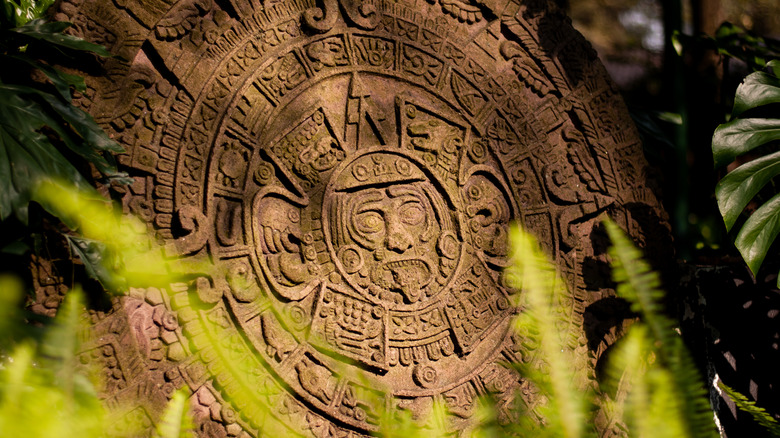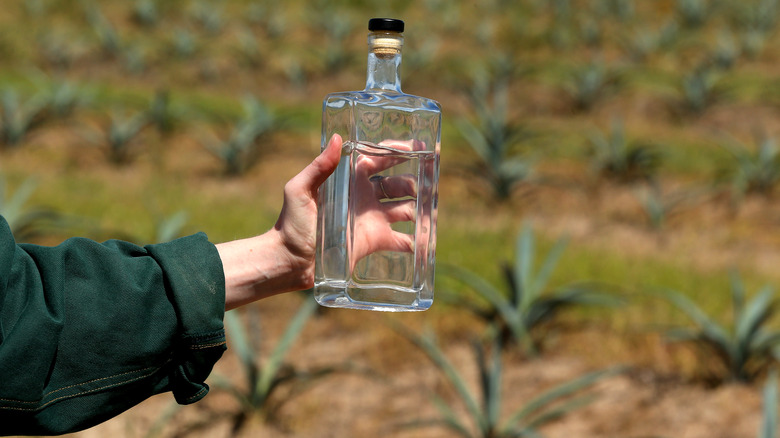What Aztec Mythology Really Says About The Agave Plant
The agave plant can be recognized by its characteristic spiky leaves with ragged, spiny tips. Typically found in arid regions of the Americas like Mexico and the Caribbean, it is used to make agave sweeteners, mezcal liquor (the kind used in tequila, per Food and Wine), and other treats, according to Britannica.
Agave plants have long been used by indigenous peoples of the Americas for a variety of purposes. Their tough, fibrous leaves make them useful in making ropes, sandals, and other handy items. But they are also highly revered for more spiritual reasons, particularly by the Aztecs, a Mesoamerican people who lived in central Mexico between the 13th and 16th centuries, per History, until they were overthrown by Spanish conquistadors.
In addition to running a flourishing empire, the Aztecs had extensive mythologies that featured figures such as Huitzilopochtli, god of war and sun, and the "Feathered Serpent" Quetzalcoatl. They also worshiped the agave plant, which fell under the domain of the goddess Mayahuel, per Mexicolore.
The story of Mayahuel and Quetzalcoatl
Most Aztec legends say that agave — and the tequila that can be fermented from it — is a sacred entity and a gift of the gods. One story, according to Learn Religions, proposes that agave resulted from a love affair between the gods Quetzalcoatl and Mayahuel.
According to this legend, long ago, an evil, light-destroying, human sacrifice-demanding goddess named Tzintzimitl inhabited the skies. Her presence angered Quetzalcoatl, who rose to the skies to fight her. There, per Learn Religions, he found Tzintzimitl's granddaughter Mayahuel.
In some depictions, Mayahuel is described as a god of fertility endowed with 400 breasts. In other stories, she is a mother of divine rabbits or depicted as the wife of Patecatl, god of pulque, or fermented agave, per Aztec Calendar.
In the most famous agave origin story, Mayahuel was being held prisoner by her evil grandmother when Quetzalcoatl found her, fell in love with her, and brought her back to Earth, enraging Tzintzimitl. The two lovers disguised themselves as trees, standing close together so their leaves could touch in the breeze, but eventually, Tzintzimitl found them, and a fight ensued during which Mayahuel was killed.
The death of Mayahuel and the birth of agave
Following his lover's death, a vengeful Quetzalcoatl killed the evil goddess, thus returning light to the earth, but he was distraught. The other gods felt bad for Quetzalcoatl, and so they created an agave plant that grew on Mayahuel's grave. The plant, which had "minor hallucinogenic qualities" per Learn Religions, could produce an elixir that would bring comfort to the grieving god, and thus the earliest form of tequila, which brings comfort to the grieving, was born.
In its early days, agave was used by the Aztecs to make "pulque," a sweet fermented brew drunk at religious rites, per Fairmont Mayakoba. When the Spaniards conquered the Aztecs, they began brewing agave and mud, per Liquor, creating the blueprint for the oblivion-inducing alcohol mezcal (and thus tequila) as we know it today.


